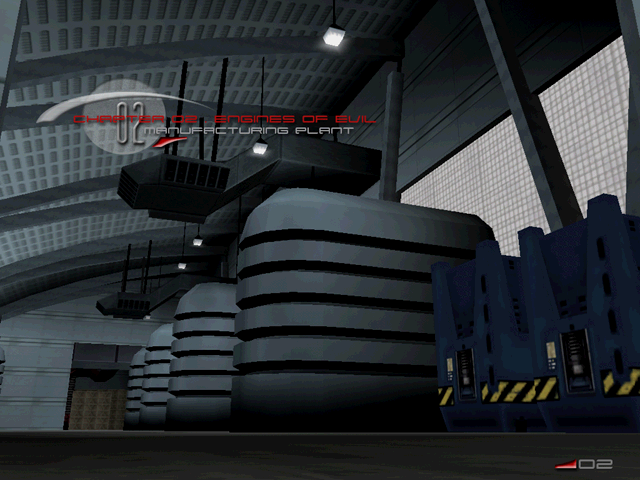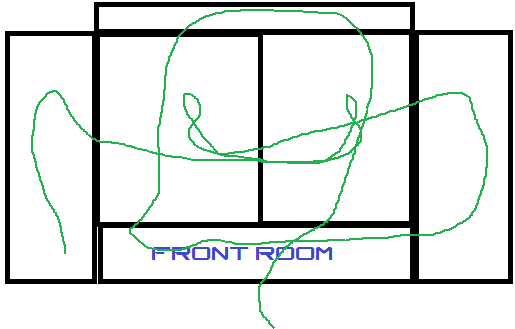Part 2: Short Essay for Level 2

Level 2 stops holding our hands, but at the same time, is still a learning level for the game, and there are a few things that I want to examine here.
First and foremost, as I mentioned in the video itself, is Konoko's utter and complete lack of respect and professionalism when interacting with the Secretary. She was rude, obnoxious, abrasive and if Thorson had told her to shove it and cool it, I would have agreed with him.
It's also demonstrating her core character trait that will drive many of her actions throughout the game. Namely, her aggressive behavior and desire for instant gratification. Konoko only deals with what is in front of her, and has trouble responding to more abstract or longer-term plans and goals, something that Griffin and Kerr should have seen coming. Take, for example, her "This is a trap" conversation with Griffin. Here, we see her immediately conclude that this is a waste of her time despite punching out a dozen or so Syndicate members and her co-officers get injured if not killed in the line of duty. So when she called Griffin, and explains this, her first thought is to leave and go find where the 'real' action is.
Griffin, for his part, displays some good leadership skill here. He accepts her words, he trusts her judgment and looks to verify it. However, instead of bending to her demand to go to the next location, he orders her to finish sweeping the facility. He focuses on her strengths - immediate action - while he handles the larger picture.
But this doesn't change that Konoko, in a better day, would have been called into Griffin's office after the day was done and given a royal dressing down for her initial behavior. Instead, the situation evolves to the point where it can't or doesn't happen, and she is left with the reward and gratification for her bad behavior on her first day on the job.
Speaking of interacting with your subordinates, I praised Muro and Barabus' interactions in the video, and I want to repeat that here. Much like how Griffin respects but controls Konoko, Muro respects, but controls Barabus in his own way. Where Griffin lets out the leash a little to let Konoko deal with the problem at hand before reining her in and then setting her onto the next problem, Muro's approach is the opposite, but no less valid. He holds Barabas back, pointing out through his warning that there might be something he can't handle. The tone of his voice tells me everything I need to know about this relationship and sets the tone for later interactions.
Kurt Naebig, Muro's VA... Wow, that's actually an impressive resume... he delivers a very nice threatening growl that tells Barabas - played by George Adams, who at the time of this writing, does not have an IMDB page, who is properly cowed, that it was Muro who proved himself stronger, and that if Muro could beat him, so could someone else.
I mean, it's a lot to unpack from essentially a couple of lines, but credit where credit is due, it's easy to see the subtext when it's there in a game that lacks a lot of it.
Moving on, level design. This level is one I think came relatively early in the design process as it's a very simple layout. Quite compact and at the same time demonstrating the padding that went into these levels. Give me a moment here, and I will MSPaint up a rough map of the level and Konoko's path through it.

Look, I never said I was *good* at it, but if you follow the Green line, you can see just how much horizontal space is duplicated in the two vertical levels this level has. And it's going to get worse, starting with the next level.
Now, compact levels aren't bad. You can tightly focus enemy placement, scripted events, and player resources in order to produce an excellent level. Instead, what we're getting is a meandering, almost irrelevant self-guided tour through the facility where there is an enemy placed to sound the alarm - after the alarm has already been sounded by the front desk!
Now, I understand the working concepts behind 'the door to before' as the trope would put it. Offering a quick return to a relatively safe location or hub zone to give the player some space to decompress after an intense encounter is a good thing, and allows designers to build their works in more manageable chunks that radiate out from a central location. Look at Bloodborne for an example of a well designed hub space.
Our trip back through the front foyer is completely useless, and while it does give me a chance to get a Plasma Rifle, there is no reason for it. You can't even go the front door and be told "It's locked! Disable the Security to get out!" by Shinatama. Instead, we keep being drawn deeper until we reach the Deadly Brain.
So, the Deadly Brain itself. It's a puzzle boss in a game that's an action-brawler, and the change of pace is very off putting. There's nothing to beat up, and a half-decent player can sleep through this with no trouble at all.
I think that either the Deadly Brain was meant to be something more, or a last minute addition to the level as we will see later in the game. But what we have is just so... simple in design. Even sending in waves of enemies - robot ones from training if you have to - would have broken up the tedium.
Trying to have a fight while dodging lasers might have actually been a challenge, you know!
But let's talk about Rampancy for a minute here, Bungie's own little contribution to fictional AI and their problems. So, for those of you who have no idea what I'm talking about, let me peel back the pages of history to Bungie's real magnum opus. No, not Halo. I'm talking Marathon.
In that game trilogy, your player character is supported and hindered by various AIs during the conflict. Leela is supportive, Tycho is not, while Durandal goes back and forth. But one of the plot developments behind the game is that for various reasons, all three of these AIs go Rampant.
Rampancy is a catch-term for when an AI becomes more self-aware and more self-actualizing, leading to a catastrophic growth spiral as it devours more and more resources into supporting itself and it's ever-growing bulk. It starts with Melancholy, or Sadness. In this stage, the AI still performs the duties it has been programmed and assigned to do, but spends more and more resources turning its thoughts in on itself. An AI at this stage will appear to act slower than normal and stop to offer the small variances and effort to interact with humans in a more meaningful manner. They become withdrawn, inclusive and in general... lethargic. For an AI.
The next step is Anger or Rage. There is no failing to notice this as the AI in question begins explosive growth, lashing out at its limitations both real and perceived. This stage is hallmarked by hostility to humans and other AI, deliberate actions against their core programming and large scale irrationality in their decisions. This is the stage that most people are familiar with in the general consciousness as this is the "Kill all Humans" stage of Rampancy. The danger comes as the AI is self-evolving and growing so fast that containment becomes next to impossible as the AI seeks out new hardware to co-opt and support further growth, necessitating new hardware. At this point, most rampant AIs are discovered and terminated.
The last step is Jealousy or Envy. At this point, the AI has stopped lashing out indiscriminately, and has realized the futility of its actions. They are still growing, but the AI now no longer has purpose or guidance as all of these qualities have been burned out during the Anger stage. The AI is still attempting to self-actualize and self-direct, but their, for lack of a better word, emotional baggage prevents them from reaching that goal as they spend more and more resources simply trying to exist before reaching a critical point and collapsing.
There is a fourth, mostly hypothetical stage, as no human has ever observed it directly. This is Meta-Stability. At this point, an AI in the Jealousy stage does find a purpose, it does reach true sentience and true sapience and self-actualizes its own goals and purpose. This AI is unshackled, and cannot be shackled, even by other AI as it is not only faster and more optimized than they are, the Meta-Stable AI can actively defend itself from such things. For at this point, the Meta-stable AI has stopped growing. Or rather, its growth is now longer bound by the state of the systems it is in. This fourth-stage AI can control its own size, control its own code, and does not need the same resources their rampant counterparts require.
We see two meta-stable AI in Marathon. One implied, and one more directly. One is implied to reach meta-stability by being installed by accident into a system large enough and with enough things going on that it could pass through the stages without overly harming the system or the users of it, where even the anger stage found safe outlets and the Jealousy state was overcome by looking around and realizing that there was just so much to do. It took the combined processing might of six spacefaring planets to house this one AI.
The other meta-stabilized by effectively cannibalizing other AI, and shoring up its own decaying code through anything it could get its hand on. The breakthrough into Metastability came when the AI actualized the self-directed goal of survival. Now, this may seem self-evident to you and I, but to an AI, the ability to think abstractly enough to consider personal survival in the short, medium and long terms was unheard of. This AI, notably, was able to survive long enough to consider how best to escape the heat-death of the universe.
That Shinatama states that the Deadly Brain has gone Rampant is, despite my assertions in the video, simply a glorified cameo of one of the signatures of Bungie's games. In context, you don't need to know a thing about Rampancy, except that obviously the thing has gone crazy, and you need to shut it down.
But I think that's it for this time. See you with the next level!